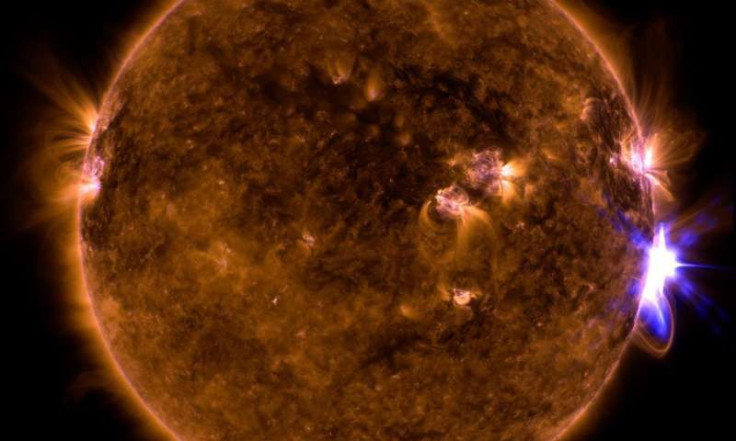WATCH: NASA Captures Huge Solar Flare Eruption On Sun

The Sun witnessed unusual solar flare activities during the last few days in its solar minimum, a period in its cycle when its surface is relatively sunspot free.
NASA's Solar Dynamics Observatory captured a powerful solar flare on Sept. 10 at 12:06 PM EDT.
The observatory which is solely dedicated to viewing the Sun captured this Class-X flare, which are the highest intensity flares. This comes just a few days after two Class X flares were spotted on Sept. 6.
Solar flares are generally the result of the expulsion of accumulated magnetic energy in some places. These ionized particles build-up enough energy to propel themselves thousands of kilometers out into the solar system.
The Sun was lively this week, releasing several solar flares. Here's what @NASA's @NASASun satellites saw: https://t.co/l0ClnDD6mu pic.twitter.com/ESY9iKM0mO
— NASA Goddard Images (@NASAGoddardPix) September 9, 2017
The Sun emitted many sizable solar flares Sept. 4-8, including the strongest since at least 2008. Watch & read more: https://t.co/UMs3kDbLx2 pic.twitter.com/3ZPH2sjiZ0
— NASA Sun & Space (@NASASun) September 11, 2017
Our sun has entered a dormant period. A solar cycle is a 11 year period where the Sun alternates between two periods: solar maximum — when sunspots are much more frequent on the Sun’s surface — and solar minimum — when the Sun’s surface is relatively sunspot free.The current cycle started 2008. The high activity period, which is marked by an increased number of sunspots and solar flares, ended in 2014.
Yesterday's strong solar flare (X8.2) is visible on the right in this animation from our Solar Dynamics Observatory https://t.co/UMs3kDbLx2 pic.twitter.com/uBs2b8D8FS
— NASA Sun & Space (@NASASun) September 11, 2017
Naturally these sightings come as a surprise as there is a deviation from the usual pattern.
It was reported by CNET on Sept. 6 that the same observatory recorded two X Class flares on the Sun.
.@NASASun just emitted two significant solar flares! Check them out here: https://t.co/lTHUe26FC1 pic.twitter.com/ENRObXdvPH
— NASA Goddard (@NASAGoddard) September 6, 2017
The GIF uploaded by NASA shows the two flares. The first flare was categorized as X2.2, while the second one, which is visibly much more intense, scored a whopping X9.3.
According to NASA, the second flare was the largest recorded in this solar cycle.
NASA estimated the energy produced from the solar flare to be equivalent to a billion hydrogen bombs. The radiation and plasma emanating from this flare hurtled towards Earth but will be stopped by our atmosphere.
The Space Weather Prediction Center (SWPC) has said that the category X eruptions from the surface of the Sun can disrupt high-frequency radio signals on Earth for over one hour. But this effect will be restricted to the side of the Earth facing the Sun only.
Solar storms are known to disrupt communications signals, GPS and power grids by reaching the upper Earth atmosphere. They are also responsible for some of the most magnificent aurora sightings on Earth when they interact with our atmosphere.
A team from various UK universities studied the flares on Sept. 6 using the Swedish Solar telescope in La Palma. The findings and the video of the flare were published in a report on the University of Sheffield website.
Since the two separate occasions of X rated solar flares during this period is a very rare occurrence, researchers who published this paper say that the findings will help them acclimatize themselves with these anomalies and give them enough data to help start a prediction pattern for them in the future.
The increased activity has been credited to a large solar spot which was directly facing Earth. Scientists, in the paper, say that the anomalies will disappear once the solar spot vanishes from sight. It also helps them predict the effect of solar spots on our planet in better detail.
© Copyright IBTimes 2025. All rights reserved.





















